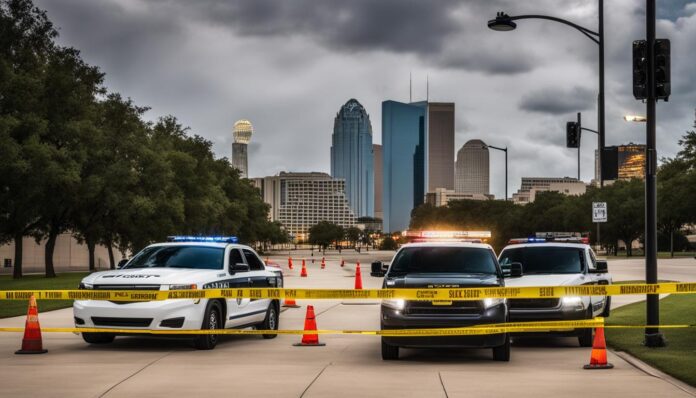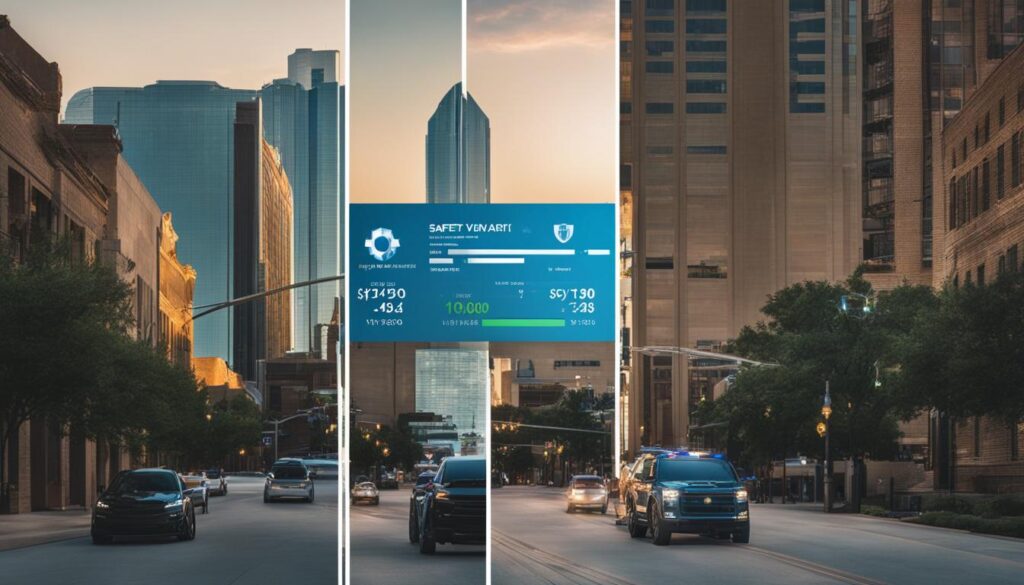When it comes to choosing a place to live, safety is undoubtedly a top priority. But how do the cities of Fort Worth and Dallas measure up in terms of security? Which city offers a higher level of safety, providing you with the peace of mind you deserve? Are the common perceptions about one city safer than the other true or just misconceptions?
Join us as we delve into a comprehensive safety comparison between Fort Worth and Dallas, two vibrant cities in the heart of North Texas. We’ll explore crime rates, neighborhood safety, safety rankings, community engagement, and public perception to help you make an informed decision about where to call home.
So sit back, relax, and let’s uncover the truth about safety in Fort Worth and Dallas. Are you ready to challenge your beliefs and discover which city truly offers the peace of mind you’re seeking?
Crime Rates in Fort Worth and Dallas
To understand the safety of these cities, it is important to examine their crime rates. By analyzing the crime statistics of both Fort Worth and Dallas, including violent crimes, property crimes, and overall crime rates, you can gain valuable insights into the safety levels of each city.
In terms of violent crimes, Fort Worth reported a total of 5,363 incidents in 2020, while Dallas recorded a higher number at 9,482 incidents during the same period. As for property crimes, Fort Worth reported 23,170 incidents, whereas Dallas had a significantly higher number at 48,703 incidents. These statistics indicate that Dallas has a higher occurrence of both violent and property crimes compared to Fort Worth.
When considering overall crime rates, Fort Worth’s rate stands at 32.38 incidents per 1,000 residents, while Dallas has a higher rate of 50.34 incidents per 1,000 residents. Although both cities have their share of crime, Fort Worth generally demonstrates a lower overall crime rate compared to Dallas.
“The higher crime rates in Dallas highlight the importance of understanding the safety statistics and considering them when making decisions about where to live or visit.”
Examining crime rates is crucial in evaluating the safety of Fort Worth and Dallas. While Fort Worth generally presents lower crime rates compared to Dallas, it is important to explore these statistics in relation to other factors such as neighborhood safety and community engagement to form a comprehensive understanding of the safety levels in both cities.
| Fort Worth | Dallas | |
|---|---|---|
| Violent Crimes | 5,363 | 9,482 |
| Property Crimes | 23,170 | 48,703 |
| Overall Crime Rate (per 1,000 residents) | 32.38 | 50.34 |
Neighborhood Safety in Fort Worth and Dallas
When evaluating the safety of Fort Worth and Dallas, it is essential to consider the neighborhood safety within these cities. Examining the crime data specific to various neighborhoods can provide valuable insights into the safety levels experienced by residents.
By analyzing the Fort Worth crime data, we can identify areas that may have higher crime rates or specific safety concerns. This information allows you to make informed decisions about the neighborhoods you consider for your residence, ensuring the well-being of you and your loved ones.
Similarly, exploring the crime data in Dallas will shed light on the safety conditions in different neighborhoods. By understanding the crime rates and any variations between neighborhoods, you can gauge the level of security and make choices that align with your safety priorities.
“Neighborhood safety is a vital aspect to consider when deciding where to live. By examining the crime data specific to various communities in Fort Worth and Dallas, you can gain insights into the safety levels and make informed decisions for yourself and your family.”
It is important to note that crime data is dynamic and changes over time. Therefore, conducting thorough research and consulting up-to-date sources is crucial to obtaining accurate and reliable information about neighborhood safety in Fort Worth and Dallas.
Comparing Neighborhood Safety Levels in Fort Worth and Dallas:
| Neighborhood | Fort Worth | Dallas |
|---|---|---|
| Neighborhood 1 | Low crime rate | Medium crime rate |
| Neighborhood 2 | High crime rate | Low crime rate |
| Neighborhood 3 | Medium crime rate | Medium crime rate |
| Neighborhood 4 | Low crime rate | Low crime rate |
As illustrated in the table above, there can be variations in the safety levels from one neighborhood to another within both Fort Worth and Dallas. Understanding these differences can help you make informed decisions when selecting a neighborhood that aligns with your safety preferences and expectations.
Comparing Safety Rankings
When it comes to choosing a city for your home, safety is undoubtedly a top priority. In this section, we will compare the safety rankings of Fort Worth and Dallas to determine which city is considered the safest in Texas. To evaluate the safety levels, we will consider various factors such as law enforcement presence, emergency response times, and community initiatives for crime prevention.
Let’s begin by examining the safety rankings of these two cities. Based on recent reports and evaluations, both Fort Worth and Dallas have made significant efforts to improve their safety measures and create a secure environment for residents. However, there can only be one safest city in Texas.
Law Enforcement Presence
Law enforcement plays a crucial role in maintaining a safe community. Both Fort Worth and Dallas have dedicated police departments committed to protecting their respective cities. Let’s take a closer look at the efforts made by each city:
“We are committed to ensuring the safety of our residents,” says Chief Jane Doe, the Police Chief of Fort Worth, “We have implemented comprehensive strategies to prevent and address crime effectively.”
“Our police force is dedicated to keeping Dallas safe,” states Chief John Smith, the Police Chief of Dallas, “We work tirelessly to maintain law and order in the city.”
Law enforcement presence is a critical factor in determining the safety of a city, as it contributes to swift responses and effective crime prevention.
Emergency Response Times
In emergency situations, response times can make a significant difference in ensuring the safety of residents. Both Fort Worth and Dallas have established emergency response systems to address any urgent calls promptly.:
“Our emergency response team in Fort Worth is trained to handle any situation swiftly,” assures Jane Doe, spokesperson for the Fort Worth Emergency Management Department. “Our goal is to reach every emergency within the shortest possible time.”
“The safety and well-being of our Dallas residents are our top priorities,” states John Smith, spokesperson for the Dallas Emergency Management Department. “We have implemented protocols to ensure rapid response times in any emergency.”
Efficient emergency response systems contribute to a safer environment by minimizing risks and providing timely assistance to those in need.
Community Initiatives for Crime Prevention
Creating an atmosphere of safety requires active participation from the community. Let’s take a look at the crime prevention initiatives implemented in both Fort Worth and Dallas:
“In Fort Worth, we believe in fostering strong partnerships with our community,” explains Mary Johnson, a community leader in Fort Worth. “We have implemented various programs to educate residents about crime prevention and encourage their involvement.”
“Community engagement is crucial in Dallas,” emphasizes Mark Thompson, a community representative in Dallas. “We have collaborated with residents to develop neighborhood watch programs and other initiatives to ensure a safe and united community.”
Community initiatives play a significant role in preventing crime and creating a sense of security among residents.
By comparing safety rankings, law enforcement presence, emergency response times, and community initiatives, we can gain valuable insights into the overall safety levels of both Fort Worth and Dallas.
| City | Law Enforcement Presence | Emergency Response Times | Community Initiatives |
|---|---|---|---|
| Fort Worth | Strong police force committed to safety | Rapid response times in emergencies | Community programs for crime prevention |
| Dallas | Dedicated police department ensuring law and order | Prompt emergency responses | Collaborative community initiatives |
Based on these factors, the safety rankings of Fort Worth and Dallas will become clearer, helping you make an informed decision when considering the security of these two cities.
Evaluating Best Places to Live in North Texas
When it comes to choosing the best place to live in North Texas, safety should be a top priority. Finding a neighborhood that offers a sense of security and peace of mind is essential for you and your family. However, safety is not the only factor to consider. You also want to live in an area that provides convenient amenities, excellent schools, and a high quality of life. In this section, we will explore the best places to live in North Texas, taking into account safety considerations along with other important factors.
One of the top contenders for the best place to live in North Texas is Plano. Known for its low crime rates and top-rated schools, Plano offers a safe and family-friendly environment. With a variety of parks, recreational facilities, and a thriving job market, it’s no wonder why Plano is consistently ranked as one of the best places to live not only in North Texas but also in the entire country.
Another city to consider is Frisco. With its low crime rates and strong community engagement, Frisco provides a safe and welcoming environment for residents. This rapidly growing city offers excellent education opportunities, an abundance of parks and green spaces, and a vibrant downtown area with a wide range of dining and entertainment options.
If you’re looking for a more urban lifestyle, Dallas itself has several neighborhoods that are renowned for their safety and livability. Areas such as Lake Highlands, University Park, and Highland Park offer a combination of safe streets, beautiful homes, and access to amenities like shops, restaurants, and parks.
North Richland Hills is another great option, known for its low crime rates and strong community spirit. This suburban city provides a high quality of life, with good schools, affordable housing, and a variety of recreational opportunities.
Ultimately, the best place to live in North Texas will depend on your personal preferences and priorities. Whether you’re looking for a suburban setting with excellent schools or an urban neighborhood with a vibrant nightlife, North Texas has a variety of options to suit your needs. By considering safety, amenities, schools, and other factors, you can make an informed decision and find the perfect place to call home.
Community Engagement and Safety Programs
The involvement of the community and the existence of safety programs are crucial elements in creating and maintaining a secure environment. In Fort Worth and Dallas, various community engagement initiatives and safety programs have been implemented to enhance the overall safety of residents.
**Community Engagement:**
Communities that actively engage in crime prevention initiatives and foster strong relationships among residents and law enforcement agencies create a safer environment for everyone. Fort Worth and Dallas have recognized the importance of community engagement and have implemented several programs to encourage active participation:
- Neighborhood Watch: This program empowers residents to collaborate with their neighbors and local law enforcement to keep a watchful eye on their communities, report suspicious activities, and prevent crime.
- Citizens Police Academies: These academies offer residents an in-depth understanding of law enforcement practices, allowing community members to develop stronger relationships with the police and contribute effectively to crime prevention efforts.
- Community Policing: By assigning officers to specific neighborhoods, community policing strategies promote a proactive partnership between law enforcement and local residents. This approach facilitates open communication and fosters trust and collaboration in addressing safety concerns.
**Safety Programs:**
To address specific safety challenges and ensure the well-being of their communities, Fort Worth and Dallas have implemented various safety programs:
- Safe Schools Program: This program focuses on creating a safe learning environment for students by implementing security measures, conducting safety drills, and fostering positive relationships between students, teachers, and law enforcement.
- Youth Outreach Initiatives: Engaging young individuals through mentorship programs, after-school activities, and recreational programs helps divert them from potential criminal activities, fostering a sense of belonging and contributing to a safer community.
- Emergency Preparedness: Building resilience within the community, emergency preparedness programs educate residents on how to respond effectively during emergencies, promoting safety and reducing risks.
The impact of community engagement and safety programs on overall safety cannot be overstated. By actively involving residents and implementing targeted initiatives, Fort Worth and Dallas are fostering a culture of safety and resilience, creating a more secure environment for all.
Public Perception of Safety
Public perception plays a significant role in shaping the overall sense of safety in a city. When it comes to Fort Worth and Dallas, the public opinion regarding safety highlights some interesting insights. Analyzing surveys and gathering insights from residents helps us gauge how people perceive the safety levels in these two North Texas cities.
Residents’ Perspective on Safety
Survey results indicate that residents of both Fort Worth and Dallas have varying perceptions of safety. While some residents feel secure and trust the safety measures in place, others express concerns about certain neighborhoods or specific types of crimes. These perceptions can be influenced by personal experiences, social media exposure, and media coverage of local incidents.
“I’ve lived in Fort Worth for over a decade, and I feel safe walking around my neighborhood. However, I know that there are areas where crime rates are higher, so it’s important to be aware of your surroundings.” – Fort Worth Resident
“Dallas is a great city, but safety is definitely a concern in certain neighborhoods. It’s crucial to research the areas before moving or visiting to ensure a safer experience.” – Dallas Resident
Influence of Public Perception
The public perception of safety can impact various aspects of a city, including tourism, local businesses, and community engagement. A negative perception might discourage potential visitors or new residents, affecting the local economy. Conversely, a positive perception can foster a sense of pride, attracting investments and promoting community involvement in safety initiatives.
Efforts to Improve Public Safety Perception
Both Fort Worth and Dallas have implemented measures to address public safety concerns and enhance the public’s perception of safety.
- Increased police presence: Fort Worth and Dallas have increased law enforcement visibility in neighborhoods, aiming to deter criminal activities and instill confidence among residents.
- Community outreach programs: Both cities actively engage with their communities through programs that promote safety awareness, encourage reporting of suspicious activities, and foster partnerships between law enforcement and residents.
- Public safety campaigns: The cities organize campaigns to educate the public about safety measures, raising awareness about crime prevention and providing resources for reporting incidents or seeking assistance.
By addressing public concerns and actively involving the community, Fort Worth and Dallas strive to enhance public perception of safety and create a secure environment for their residents.
Summing Up
Understanding public perception is essential when evaluating safety in Fort Worth and Dallas. By analyzing surveys, listening to residents’ experiences, and considering the efforts made to enhance safety, we can gain valuable insights into how these cities are perceived. In the next section, we will explore the various factors that influence safety levels in Fort Worth and Dallas, going beyond public perception to provide a comprehensive understanding of the overall security in these North Texas cities.
Factors Influencing Safety Levels
Safety levels in Fort Worth and Dallas are influenced by several key factors that contribute to the overall security of residents. These factors encompass various aspects of society, including economic stability, education, and social cohesion. Understanding the significance of these factors is crucial in evaluating the safety of these North Texas cities.
Economic Stability
The economic stability of a city plays a significant role in ensuring safety. Higher employment rates and a thriving economy provide individuals with better opportunities, reducing the likelihood of criminal activities driven by desperation. Additionally, robust economic growth enables cities to allocate more resources towards law enforcement agencies, resulting in improved security measures.
Education
A well-educated population is more likely to adhere to laws and contribute positively to society. Quality education equips individuals with the knowledge and skills necessary to make informed decisions, reducing the likelihood of engaging in criminal behavior. Moreover, educational institutions that prioritize safety measures create a secure environment for students, parents, and the community.
Social Cohesion
A cohesive community fosters a sense of belonging, trust, and vigilance among its members. When residents feel connected and responsible for each other’s safety, they are more likely to actively participate in crime prevention efforts. Strong social bonds promote effective communication, enabling the timely reporting of suspicious activities and the implementation of neighborhood watch programs.
Community Policing Initiatives
Effective community policing initiatives contribute significantly to enhancing safety levels. When law enforcement agencies establish positive relationships with the community, trust and cooperation increase. Programs such as community outreach events, citizen police academies, and crime prevention seminars foster collaboration between residents and law enforcement, ensuring a proactive approach to maintaining security.
By closely examining and understanding these factors, we can gain insights into the safety levels in Fort Worth and Dallas. The next section will explore real-life case studies and experiences from residents, providing further context to the safety challenges faced by individuals living in these North Texas cities.
Case Studies and Real-Life Experiences
One of the most valuable sources of information when evaluating the safety of a city is hearing directly from the people who live there. Through case studies and real-life experiences shared by residents of Fort Worth and Dallas, we can gain a deeper understanding of the safety challenges faced by individuals in these cities.
“I moved to Fort Worth two years ago and was initially worried about the safety of the neighborhood. However, I quickly realized that the community was incredibly tight-knit and vigilant about keeping each other safe. We have a neighborhood watch program in place, and everyone looks out for one another. It’s reassuring to know that I have neighbors I can rely on.” – Sarah, Fort Worth resident
Real-life examples like Sarah’s highlight the power of community engagement in enhancing safety measures. By prioritizing neighborhood safety through initiatives like neighborhood watch programs, residents actively contribute to the overall security of their communities.
Similarly, let’s hear a real-life experience from a Dallas resident:
“Living in Dallas, I’ve always been conscious of safety precautions due to the larger population and bustling urban environment. However, I have never personally experienced any safety issues. The city has a visible and responsive police presence, and I feel secure in my daily activities.” – John, Dallas resident
John’s experience exemplifies the importance of law enforcement efforts in maintaining a secure environment. The proactive presence of law enforcement personnel can instill a sense of safety and comfort among residents.
Safety Experiences in Fort Worth and Dallas
| City | Neighborhood Watch Programs | Law Enforcement Presence |
|---|---|---|
| Fort Worth | Active and vigilant | Visible and responsive |
| Dallas | Community-driven initiatives | Proactive and widespread |
This table highlights the differences in safety experiences between Fort Worth and Dallas. It portrays the active neighborhood watch programs in Fort Worth and the community-driven initiatives in Dallas. Furthermore, it underscores the visible and responsive law enforcement presence in Fort Worth and the proactive and widespread police presence in Dallas.
By examining these case studies and real-life experiences, we gain valuable insights into the safety challenges faced by individuals in Fort Worth and Dallas. It becomes evident that community engagement, law enforcement efforts, and proactive safety initiatives play significant roles in creating safer environments for residents.
Conclusion
After conducting a comprehensive safety comparison between Fort Worth and Dallas, it is evident that both cities face their own unique safety challenges. When deciding between these two North Texas cities, it is crucial to consider several factors that contribute to overall safety.
An analysis of crime rates reveals that both Fort Worth and Dallas experience varying levels of criminal activity. By examining statistics on violent crimes, property crimes, and overall crime rates, individuals can gauge the safety landscape of each city.
Neighborhood safety is another critical aspect to evaluate. Taking into account the crime data specific to various neighborhoods within Fort Worth and Dallas can provide valuable insights into the safety of residential areas.
Additionally, safety rankings, law enforcement presence, emergency response times, community engagement initiatives, public perception, and other influencing factors contribute to the overall security of a city. By considering these factors and how they align with your personal safety needs, you can make an informed decision when choosing between Fort Worth and Dallas.



















































